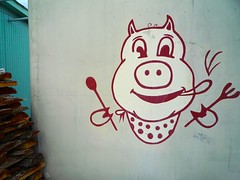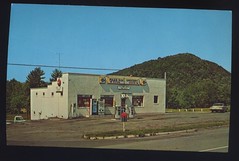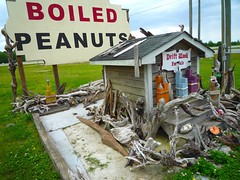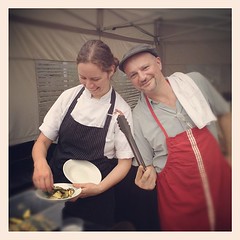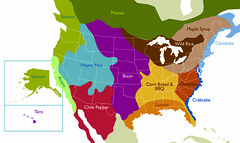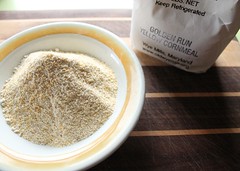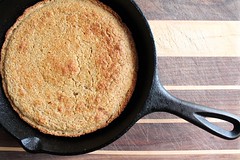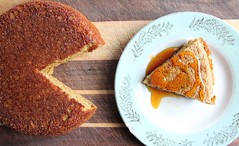On The Road 6: North Carolina BBQ Mini-Odyssey
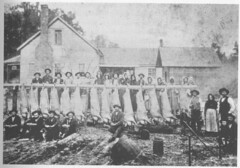 fig. a: old-school NC pig roast
fig. a: old-school NC pig roast
North Carolina. Fabled birthplace of American barbecue. And a state where pig is king.
 fig. b: court jester
fig. b: court jester
Actually, North Carolina's a state where pig is sometimes also the court jester. Quite literally.
The photograph directly above was taken in Lexington, NC, in front of the Davidson County Courthouse. This pig statue pays some kind of tribute to Lexington's status as the Barbecue Capital of the World (or, at the very least, the Barbecue Capital of North Carolina). Of course, Lexington's not the only town to claim to be the Barbecue Capital of the World, and it's probably not the only town in North Carolina that thinks of itself as the Tarheel State's Barbecue Capital, but it's got a pretty decent claim on both titles. It's a major barbecue pilgrimage point with an astounding number of barbecue restaurants per capita (it's got about 20, and its population is just under 19,000, so roughly 1 for every 950 citizens), a number of which are among the most esteemed in the business, and it's got a style all its own. If all that wasn't enough, it also plays host to the Lexington Barbecue Festival--one of the world's largest--every fall.
Now Lexington may not have been the place where barbecue originated--the Anglo-American tradition dates back to First Contact, after all--but it's certainly got a long history there. Some of the earliest barbecues in the city itself actually took place in back of the County Courthouse, on a tiny stretch of road that became known as Barbecue Alley, where the earliest purveyors of Lexington barbecue (within city limits, that is) took advantage of the courthouse's central location and its hungry jurists.
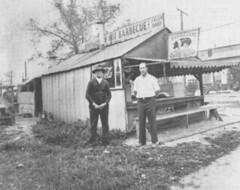 fig. c: early Lexington BBQ
fig. c: early Lexington BBQ
It'd be great if Barbecue Alley was still a hotspot for Lexington barbecue, but this is what it looks like today.
 fig. d: "Barbecue Alley" today
fig. d: "Barbecue Alley" today
To find Lexington's famed barbecue establishments, you've got to travel a little ways from the geographic centre. There may be lingering ghosts around Barbecue Alley, but with the exception of late October, when the Barbecue Festival is on, the action is happening elsewhere.
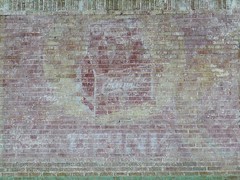 fig. e: Drink
fig. e: Drink
Lexington Barbecue
My Lexington pilgrimage was short, but it was definitely sweet. It started at perhaps the most hallowed barbecue establishment in all of Lexington, Wayne "Honey" Monk's Lexington Barbecue, a.k.a. Lexington Barbecue #1, The Monk, The Honey Monk, or Honey Monk's. Lexington Barbecue has been winning over devotees and racking up distinctions for over 50 years now, and it's the only barbecue in Lexington to have won a James Beard Foundation award as one of America's Classics.
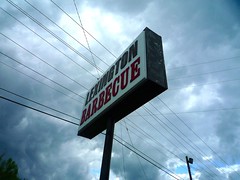 fig. f: #1
fig. f: #1
Lexington Barbecue is a large, barn-shaped restaurant with very few frills to it of any kind. The specialty, of course, is their pork barbecue, served in a range of plates, platters, and sandwiches. The default mode for Lexington Barbecue's pork is finely chopped, as it is across much of North Carolina. But the style here is one that's typical of the city of Lexington, and of the Piedmont region more generally: dressed with a dip that features tomato ketchup prominently, and served alongside a "red" cole slaw that also features ketchup prominently. The meat is supremely tender, and the 10+ hours of smoking time imparts a lovely smoky flavour, but Lexington Barbecue uses primarily oak on its shoulders, so the smokiness is surprisingly mild. The presentation may lack a certain artistry, but this is masterful barbecue.
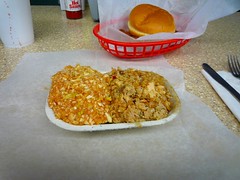 fig. g: Lexington Barbecue's platter
fig. g: Lexington Barbecue's platter
Plates of pork barbecue are commonly served with either buns or hush puppies, but if you ask real nice you can get an order of "half 'n' half," which is exactly what I did. Texas Pete hot sauce (the pride of North Carolina) and a large cup of Cheerwine (like my server told me, "It's kinda like cherry cola, only better") completed the scene.
I tried to really savour my platter--this was a pilgrimage, after all--but I was pretty hungry by this point, and that barbecue was just too damn good. I polished off that platter in no time.
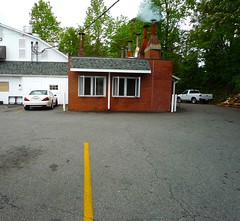 fig. h: Lexington Barbecue's pit
fig. h: Lexington Barbecue's pit
Out back, you can see Lexington Barbecue's brick smoking pit chugging away, with their pile of hardwood close at hand. Classic.
BBQ Center
 fig. i: BBQ Center
fig. i: BBQ Center
I'd been told that Lexington's BBQ Center was the home of an excellent ice cream counter that served up some legendary banana splits. But, as their name suggests, BBQ Center is primarily another serious barbecue establishment, and one that's even older that Lexington Barbecue ("since 1955"), so I took a pass on the ice cream and opted for a barbecue pork sandwich for dessert instead.
 fig. j: iconography 1
fig. j: iconography 1
Not that I had my doubts or anything, but I could tell these guys were the real deal from the moment I pulled into the parking lot. They had the iconography down, they had plenty of hardwood at the ready, and their pit was smokin' away.
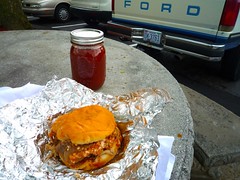 fig. k: BBQ Center's sandwich
fig. k: BBQ Center's sandwich
BBQ Center still offers good old-fashioned, mid-20th-century-style curb service, but I picked up my barbecue sandwich (coarsely chopped, this time) and had it on a picnic table outside with a soda and a side of their famous dip. I liked the coarse cut of the meat, and the smokiness of the meat was downright bold compared with Lexington Barbecue. I wasn't even all that hungry, but that smoke worked its charms on me.
Stamey's
 fig. l: Stamey's now
fig. l: Stamey's now
Stamey's is another legend of the Lexington style. Warner Stamey learned the trade in the 1920s and started his first barbecue restaurant in Shelby in 1930. He came back to Lexington for a spell and then moved on to Greensboro where he established his namesake restaurant. Warner Stamey's reputation is based on two things: his Lexington-style barbecue and his mentorship. Wayne Monk is just one of the future barbecue stars to have apprenticed with Stamey back in the day. BBQ Center's Sonny Conrad was another former pupil.
Stamey's still serves good pork barbecue (very good, in fact), and they still pride themselves on doing things the right way--smoking their meat over wood (hickory, preferably), making just about everything on the menu from scratch, keeping the operation family-run--but the flagship restaurant has been renovated numerous times over the years and the latest incarnation lacks a little charm. As a BBQ pilgrimage site, it's maybe just a little too modern, a little too generic. It's too bad it doesn't look like this anymore:
 fig. m: Stamey's then
fig. m: Stamey's then
There's no questioning Stamey's place in the family tree of Tarheel barbecue, but these days it's definitely not North Carolina's most scenic barbecue joint.
Allen & Son
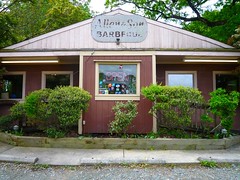 fig. n: faded glory
fig. n: faded glory
My brief North Carolina barbecue odyssey took me from west to east, which also means that it amounted to something of a backwards trip through time, in terms of barbecue history, at least. You see, while barbecue had spread far and wide across the state by the late nineteenth century, and certainly by World War I, it's generally acknowledged that the North Carolina tradition got its start in the east. It's in the east where settlers first came into contact with the region's indigenous populations. It's in the east where the history of barbecue is most thoroughly documented. And it's also in the east where the barbecue tradition is at its most primal: whole hogs cooked slowly over wood, and basted with a simple vinegar-based and chili pepper-laced concoction. On the following day of my journey I crossed over, and my first stop was Chapel Hill's Allen & Son.
Things were pretty quiet when I got there because Allen & Son opens early and I'd decided to go there for a "barbecue brunch" in order to facilitate the consumption of even more barbecue later in the day, but I didn't mind having the place to myself. Among other things, it gave me plenty of time to admire my surroundings. Allen & Son has the quirkiest, most idiosyncratic interior I'd yet encountered. It's some kind of folksy, friendly, frontier fantasy they've got going on in there, featuring a wide range of old-timey artifacts and a whole lot of taxidermy.
Allen & Son is owned and operated by Keith Allen, a hulking figure of a man who has a fondness for hickory, who collects and chops all his own wood, and who prefers to work his pit and chop his pork all by himself, too. There's definitely something of the frontiersman in Allen, and he definitely looks the part. Think Sterling Hayden in Nicholas Ray's Johnny Guitar and the whole aesthetic of Allen & Son suddenly makes a lot more sense.
Anyway, I had a chance to take in the scene, and study their menu, and I liked what I saw. Right down to their coy mascot.
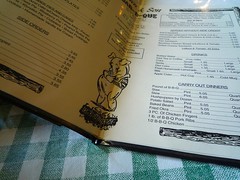 fig. o: iconography 2
fig. o: iconography 2
But what I liked most of all was my barbecue pork sandwich plate.
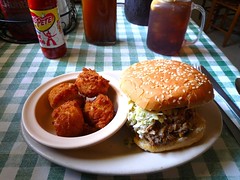 fig. p: Allen & Son's sandwich
fig. p: Allen & Son's sandwich
The pork here was coarsely cut, robustly smoky, perfectly seasoned, and quite literally juicy. The juiciest yet. The cole slaw was no longer "red"--it was creamy and "white," it had been made with obvious care, and it was first class. The bun, as you can see, was seeded and definitely above average. And the hush puppies, too, were a work of art--the best I experienced over the course of a week in NC. Hell, even their sweet tea was outstanding, with enticing hints of vanilla to it. But the biggest revelation was Allen & Son's dip, which didn't have any tomato in it, but did contain a secret ingredient: butter. I'd read about early North Carolina barbecue sauces and how butter had been a fairly common ingredient well into the nineteenth century, but I'd never actually encountered one. Allen & Son's dip also arrived fresh & hot. And, boy, did it ever make that pork sing. Wow!
Skylight Inn BBQ
 fig. q: manifesto
fig. q: manifesto
Later that day, I'd fully crossed over. By that time, I was in Ayden, NC, visiting yet another Tarheel legend: Skylight Inn BBQ. Devotees of whole hog barbecue, standard-bearers for the eastern North Carolina style, and fellow recipients of a James Beard Foundation America's Classics award, the Skylight has a reputation for being among the state's most dedicated barbecue fundamentalists. While the Skylight was only founded in 1947, the Jones family has a history of making barbecue that dates back hundreds of years. That said, for a long time the Skylight was primarily a local legend. It was only in 1979, when an article in National Geographic named Pete Jones' establishment "the barbecue capital of the world" that its reputation really began to spread far and wide.
A few years later, Mr. Jones added a rotunda--a replica of the U.S. Capitol Building's--to its roof to commemorate the nomination.
 fig. r: Barbecue Capitol
fig. r: Barbecue Capitol
The Skylight's rotunda is just about its only flourish, though. Otherwise, this is another no-frills establishment, and the ambience comes primarily from the hospitality of Bruce Jones, Pete's son, and from the musical rhythm of the chopping of barbecue that comes periodically from just behind the counter. Here, the standard serving of barbecue comes finely and freshly chopped, and the fact that it's whole hog barbecue means that the meat is more varied than most other establishments, and that crackling plays a more significant part. The cole slaw is a very simple affair, and the colour is almost electric. And the classic trio comes complete with a piece of the Skylight's traditional cornpone, which is denser and less sweet than a typical corn bread. It also comes stacked like this:
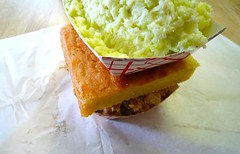 fig. s: Skylight Inn's platter
fig. s: Skylight Inn's platter
If you're going to post your barbecue philosophy up on a billboard, you better make sure you back it up, and there's no question that they do at the Skylight Inn BBQ. Just think of the amount of wood it takes to dedicate yourself to whole hog barbecue. Just look at that stack of wood they've got piled next to their barbecue pit.
 fig. t: it's definitely cooked with wood
fig. t: it's definitely cooked with wood
After Ayden, still pushing east towards the Outer Banks and the Atlantic, I soon pulled out of the heart of NC BBQ Country. I knew I'd only just scratched the surface, but I was confident traditional North Carolina barbecue was holding strong, and I knew I'd be back soon enough for another BBQ pilgrimage.
A North Carolina Barbecue Primer:
1. Remember: pig is king. Many of these restaurants have a lot of other distractions on their menus (burgers, chicken, etc.), but it pays not to stray. This should go without saying, but do yourself a favour--stick to the pork barbecue.
2. You generally have your choice of how to have your pork barbecue served to you: finely chopped (the norm), coarsely chopped, or sliced. You'll be hard pressed to find pork barbecue "pulled" in an old-school Tarheel barbecue joint. Avoid the embarrassment.
3. Barbecue sauce in North Carolina is called "dip." It's generally pretty thin, it's always vinegar-based, and it's usually pretty spicy, too. The essentials are vinegar, chili peppers/crushed red peppers, salt, and sugar. Whether it contains ketchup, tomato sauce, or some other addition depends on geography (basically: west-yes, east-no). Don't expect to find any thick, gloppy barbecue sauce on your table. Do expect to find plenty of Texas Pete, and feel free to make liberal use of it.
4. Old-school North Carolina barbecue restaurants tend to use one of two different types of wood, or a combination of the two: oak and hickory. But wood, and the smoke that comes with it, are absolutely essential. As they so delicately put it at the Skylight Inn: "If it's not cooked with WOOD, it's not BBQ." As in most other parts of the U.S., there are a lot of places in North Carolina advertising barbecue--please, for the love of BBQ, stick to the ones that cook over wood.
5. The classic North Carolina barbecue sides are cole slaw and some variation of fried or baked corn meal (usually, hush puppies, but also including corn bread, cornpone, and cornsticks). Don't expect a wide variety of other sides, although you may be pleasantly surprised from time to time (even very pleasantly surprised on occasion). A barbecue restaurant is not necessarily a meat-and-three.addresses:
Lexington Barbecue, 100 Smokehouse Lane, Lexington, NC
BBQ Center, 900 N. Main Street, Lexington, NC
Stamey's Barbecue, 2206 High Point Road, Greensboro, NC
Allen & Son Pit-Cooked Bar-B-Que, 6203 Millhouse Road, Chapel Hill, NC
Skylight Inn BBQ, 4618 S. Lee Street, Ayden, NC
Note: NC's Barbecue Country basically encompasses the entire state, from far western towns like Murphy (near the borders of Tennessee and Georgia), to eastern towns like Ayden and Goldsboro, but this particular BBQ mini-odyssey only covered about 200 miles--just far enough to fully capture the transition from West to East and from early-20th-century to early-modern in terms of style and philosophy. In other words, you could easily hit a number of these places within the space of a single day.
For more on Tarheel barbecue, John Shelton Reed & Dale Volberg Reed's Holy Smoke: The Big Book of North Carolina Barbecue (UNC Press) lives up to its name and comes complete with lore, history, recipes, addresses, and interviews. Check out this link for more information.
aj
